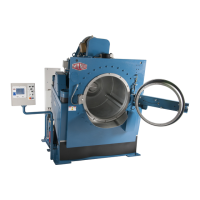24
Pellerin Milnor Corporation
Example: 2 fl oz / 64 cycles = 0.031 fl oz for each cycle
Example: 59 mL / 64 cycles = 0.92 mL for each cycle
3.1.5 Procedures for Bearing Components Connected to a
Grease Plate
BNUUUH01.R06 0000335824 A.5 A.26 A.3 10/4/21 4:04 PM Released
Your machine has a grease plate on the machine housing or the shell. You add grease to compo-
nents of the bearing housing at this location. The correct procedure is to add grease when the cyl-
inder turns at wash speed, but obey these precautions:
• For all other grease maintenance, add grease with power removed from the machine.
• If the grease plate on your machine is not serviceable (if you must add grease at a different lo-
cation), add grease with power removed from the machine.
• If you must remove a guard to get access to the grease plate, prevent access to the machine by
other personnel.
If you obey these precautions, use the Manual mode to operate the machine at wash speed. Then
add grease at the grease plate.
3.1.6 Procedures for Motors
BNUUUH01.R07 0000335823 A.5 A.26 A.7 10/22/21 8:56 AM Released
If a motor on your machine does not have grease fittings, no grease maintenance is necessary. If a
motor on your machine has grease fittings, it is necessary to add grease. But the interval is usually
longer than for other maintenance. Table 10: Motor Grease Intervals and Quantities, page 26
gives motor grease intervals and quantities for motors with specified frame sizes and speeds. You
get this data from the motor nameplate. Use Table 6: Motor Grease Schedule, page 21 to record
the data for the motors on your machine.
CAUTION: Failure to remove grease drain plugs — can cause grease to enter the
windings and burn out the motor.
� If the motor has grease drain plugs, remove them before you add
grease. If the motor has grease relief fittings, it is not necessary to remove
them.
Routine Maintenance

